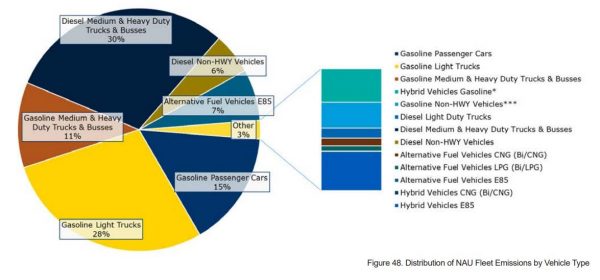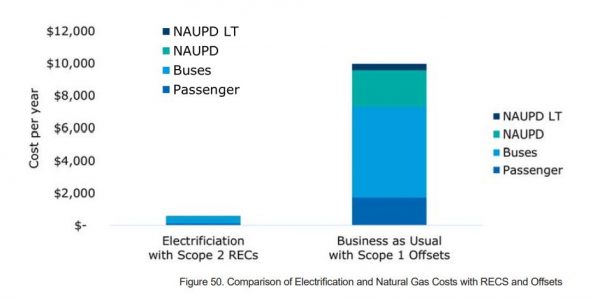Connect With Us...
Carbon Neutrality Action Plan Goals
Eliminate Fleet Related Emissions
Summary of high-level actions: The most immediate action will be the integration of vehicle charging and electric fleet management into the campus master plan. In the short term, the campus must begin to remove unnecessary and/or underutilized vehicles from multiple campus fleets (including campus shuttles), while simultaneously electrifying as many fleet vehicles on campus and not purchasing new internal combustion vehicles. These efforts will be ongoing as electric vehicle technology continues to advance through innovations in charging, battery capacity, and vehicle capabilities.
Future Electric Vehicles
Capacity Accordion Open
Capacity: Adopting EV-certified mechanic training and creating specialized EV maintenance & repair equipment. There are multiple fleet usage management systems currently used to monitor vehicle usage, but there is no single source of usage analytics. Additional costs of ½ full-time equivalent (FTE) need to be committed to evaluate the data on a regular basis and make recommendations for vehicle removal/replacement or SCEI projects.
Benefits Accordion Closed
Benefits: Reduced life-cycle operating costs per vehicle, reduced maintenance demand, increased vehicle replacement ROI, reduced total cost of vehicle ownership and potential for future ‘vehicle-to-grid’ connections for all NAU-owned vehicles to manage loads and reduce peak demand resulting in additional revenue from APS for demand side management. Co-benefits include improved campus air quality, a visible demonstration of NAU’s carbon neutrality commitment, and demystifying EVs.
Investment Accordion Closed
Investment: Pilot multiple electric vehicles for short-term and long-term lease usage as well as on-campus facilities fleet and shuttle services; Begin to develop standards and infrastructure for campus fleet vehicle charging and electrification needs including centralized charging for short-term rentals and distributed charging for long-term and departmental units; Partner with the NAU Foundation to find one-time funding to begin conversion to a fully electrified shuttle fleet.
Transportation Action Team’s Recommendations Accordion Closed
The Transportation Action Team recommended means of transitioning to a carbon-free fuel source and further motivating faculty, staff, and students to employ non-motorized transit and use mass transit. Committee recommendations stem from these needs:
- Design better pedestrian pathways and expand micro-mobility alternatives (bicycles, scooters, and skateboards and electric micro-mobility solutions such as e-bikes, e-scooters, and motorized personal vehicles). NAU should monitor the impact of these investments in motivating more non-motorized transit on campus.
- The easy availability of on-campus parking undermines efforts to reduce commuting by passenger vehicles. A study should identify means of dampening demand for on-campus parking.
- Improve EcoPass Utilization. In the fiscal year 2019, employee ecoPASS24 commuter use is about 35%, assuming an average of 10 commuting trips per week.
- Adopt educational and operational strategies with the City of Flagstaff to encourage the use of electric vehicles and mass transit trip planning as a strategy to reduce emissions and maybe a partner for trip planning.
- Trip planning is valuable and should be an important element of the university’s transportation demand management offerings.
- Continue to offer ride-sharing programs. Currently, a student-run Facebook page offers ride-sharing for students and the Northern Arizona Intergovernmental Public Transportation Authority-Mountain Line offers a vanpool program for campus commuters.
- Creating a university program to allow some employees to work at home can be impactful to demand reduction.
How NAU has Begun Efforts Accordion Closed
The NAU fleet is estimated to account for 2,000 Metric Tons of CO2 Equivalent (MTCO2e) of greenhouse gas emissions under Scope 2 with a small amount of electric vehicle charging captured under the university’s purchased electricity. As a near-term strategy, the university will downsize its fuel-vehicle fleet with the expected to result in with the expected result of increasing fuel-efficient vehicle travel.
Proposed NAU fleet transition schedule:
- By 2025, downsize the fleet and electrify most of the passenger motor pool vehicles.
- By 2030, electrify most of the facility service vehicles.
- By 2035, electrify most of the NAU bus and shuttle fleet.
- By 2040, electrify the remaining vehicles in the motor pool, facilities, buses, and shuttles, electrify most of the NAU-owned construction equipment, and focus on shifting charging and energy consumption to nonpeak and low emission periods.
- By 2050, achieve carbon neutrality as APS achieves 100% renewable energy or purchase renewable power for all fleet vehicles.
Future Action Accordion Closed
- Integrate Electric Vehicle (EV) into master plan charging and parking strategy
- Outcome: Map designated parking dedicated to EV fueling or campus and public
- Training program for EV maintenance
- Outcome: Invest in training for auto technicians for servicing EVs
- Pilot EV for short-term and long-term leases
- Outcome: Test EV practicality among motor pool operations
- Develop plans for campus charging and electrification infrastructure needs by micro fleet
- Benefits: Validate the need to incorporate EVs
- Outreach and education campaign for university fleet users
- Outcome: Increase campus-wide buy-in & support
- Establish a university minimum utilization policy for fleet usage to eliminate low-usage/older units and replace them with greener alternatives
- Outcome: Gain top-down support that is standardized and focused
- Establish a standardized fleet management framework that defines vehicle lifecycles and vehicle categories that departments purchase.
- Outcome: Generates salvage revenues to reinvest toward low-emission vehicles
- Work with the NAU Foundation to find funding for an electrified shuttle fleet
- Outcome: Promotes adequate use of green funds.
- Benefit: Reduced maintenance cost reimbursement green funds (+) $600k for pilot bus
Student Projects Accordion Closed
Undergraduate Symposium Submission, 2020 – Anthony Mirabito, Cole Bidrawn, Lindsey Toney, Selena Nevel, and Noah Dingler – CEFNS
Title:
Reducing Single Occupancy Vehicle Usage in Flagstaff
Abstract:
With global greenhouse gas emissions increasing at a concerning rate, significant attention is being focused on ways to reduce anthropogenic emissions. At the local scale, cities such as Flagstaff are taking the initiative to address these environmental concerns. One issue, and the focus of this research project, is the reduction of single-occupancy vehicle (SOV) usage in the local community. To contribute to this effort, we are working with Disability Resources, Northern Arizona Intergovernmental Public Transportation Authority (NAIPTA), and the County Board of Supervisors to extend access to the EcoPASS to NAU students who are registered with Disability Resources. Additionally, we are coordinating NAU’s first Bike Fix-It Clinic in partnership with community bike shops, the NAU Cycling Club, and the NAU Bicycle HUB, to educate students about bike maintenance and encourage alternative transportation on campus. We are in contact with local bike shops to determine their interest in volunteering their time and expertise by donating equipment, running booths, etc. This event will coincide with a tabling event at April’s Downtown Flagstaff First Friday to educate the public on SOV usage and help raise awareness for Earth Month and a Bike to School/Work Week hosted by our classmates in a different ENV 490C section. We are also in the process of producing a list of transportation grant recommendations with accompanying application information to be left for future capstone groups. The results of this project will be compiled into a final summary report to provide continuity for future projects addressing SOV usage.
Undergraduate Symposium Gallery Submission, 2021 – Marzouq Kraidees, Fatemah Alawadhi, Xingyu Liu, Mubarak Alluwimi – SCE
Title:
A low-cost platform for Electric drives Experimentation
Abstract:
Electric Drives labs have been more important for the students to know more about electric drives and DC Motors. Therefore, our project is to design a new platform to perform electric drive lab courses. We want to create a new platform because the platform we are using currently dSPACE for the electric drives labs is too expensive. We are going to replace the dSPACE with the Arduino. Arduino is a cheaper solution that can function as the dSPACE functions. Therefore, the hardware form is based on Arduino, and the software is based on MATLAB/Simulink. Our client Dr. Venkata Yaramasu teaches electric drives courses at Northern Arizona University. He is interested in power electronics and electric vehicles. In this project, these high-cost boards were replaced with low-cost, compact boards in order to perform all dSPACE labs given by our client Dr. Yaramasu. We will use an Arduino DUE, which will be cheaper than the dSPACE device. A compact inverter board is planned to be redesigned to a smaller size that will interface with the Arduino board and the DC motor. Moreover, the MATLAB/Simulink software will be used to control the electric drives by designing the circuit diagram in Simulink; therefore, it will be implemented in Arduino. Thus, this project’s main task is to replace the dSPACE hardware and software with an Arduino board receiving signals from the MATLAB/Simulink software and develop a compact inverter board in a small size to interface Arduino with electric motor drives.
Undergraduate Symposium Submission, 2020 – Goh, Boon Liang, Faisal Khamees, Yahya Molla, and Mohammed Alnuwaysir – SCE
Title:
Sensorless Control for Electric Vehicle Motor
Abstract:
At the Advanced Motors, Power Electronics, and Renewable Energy (AMPERE) laboratory, we would like to design and test the sensorless control techniques for Electric Vehicle (EV) motors such as induction motors and permanent magnet synchronous motors. These sensorless strategies offer several key features such as reduction in cost, more compactness due to the sensor absence, less maintenance system, improved noise immunity, suitability for hostile environments, and increased mechanical robustness. The goal of this project will be to design a silicon carbide traction inverter with higher reliability, efficiency, and power density which is suitable for mass market automotive applications. Additionally, this project will develop novel control for efficient motor operation at different loads both in constant power and torque regions. The speed sensorless control will improve the overall system reliability and robustness.

